The NVIDIA GeForce RTX 2070 Founders Edition Review: Mid-Range Turing, High-End Price
by Nate Oh on October 16, 2018 9:00 AM ESTOverclocking
Last, but not least, we'll take a look at overclocking. While NVIDIA does support overclocking, they have limited actual overvolting, and instead providing the ability to unlock 1-2 more boost bins and associated voltages. Either way, Maxwell 2 and Pascal certainly have much to thank for high clockspeeds; for Maxwell 2, it was a combination of high efficiency and ample overclocking headroom, while Pascal took advantage of the FinFET process to ramp up the clocks to new heights.
Built on the 12nm "FFN" process, Turing doesn't appear to push the envelope spec-wise, although it does introduce GPU Boost 4 and NVIDIA Scanner, both of which are naturally featured in EVGA's Precision tool. Re-designed into the RTX-oriented Precision X1, the utility succeeds Precision XOC, and we've opted to use that tool for our overclocking today. We adjusted the core and memory clocks, as well as the power/temperature limit and percent 'overvoltage.' For the 185W RTX 2070 Founders Edition, this is a 116% TDP limit (215W). We were unable to fully test the new Scanner functionality as it would not save to a profile and crashed on certain button presses, which is somewhat unsurprising given that Precision X1 is still in beta. But as far as NVIDIA's GPU Boost 4 is concerned, it exposes certain boost algorithms to users so that you can manually modify the voltage-frequency curve.
A total of four different overclocks were tested. First was a baseline, consisting of 100% overvoltage and max power/temperature limits. The second was overclocking the GDDR6 memory by 1Gbps. The third was overclocking the GPU by +100MHz; in practice this resulted in observed clocks between 1900 and 1990 MHz. Lastly, all previous adjustments were combined for an overall overclock.
| RTX 2070 Founders Edition Overclocking | |||||||
| Stock (FE) | Baseline | Memory OC | GPU OC | All OC | |||
| Core Clock | 1410MHz | 1410MHz | 1410MHz | 1510MHz | 1510MHz | ||
| Boost Clock | 1710MHz | 1710MHz | 1710MHz | 1810MHz | 1810MHz | ||
| Max Boost Clock | 2160MHz | 2160MHz | 2160MHz | 2160MHz | 2160MHz | ||
| Memory Clock | 14Gbps | 14Gbps | 15Gbps | 14Gbps | 15Gbps | ||
| Max Voltage | 1.050v | 1.087v | 1.087v | 1.087v | 1.087v | ||
| Power Limit | 185W (100%) | 215W (116%) | 215W (116%) | 215W (116%) | 215W (116%) | ||
Naturally, these results cannot be taken as representative of all RTX 2070 Founders Edition cards, but results here can offer some insight.
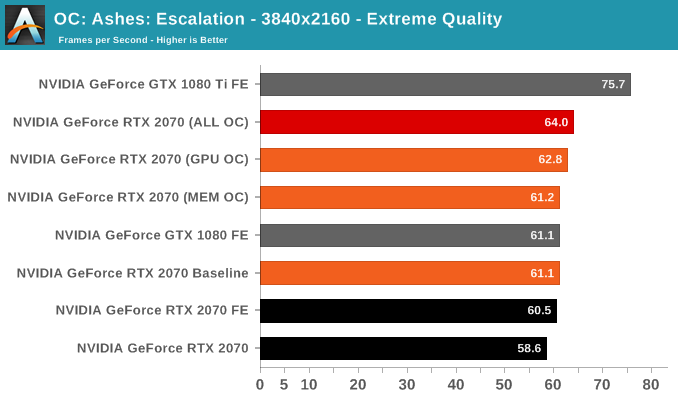
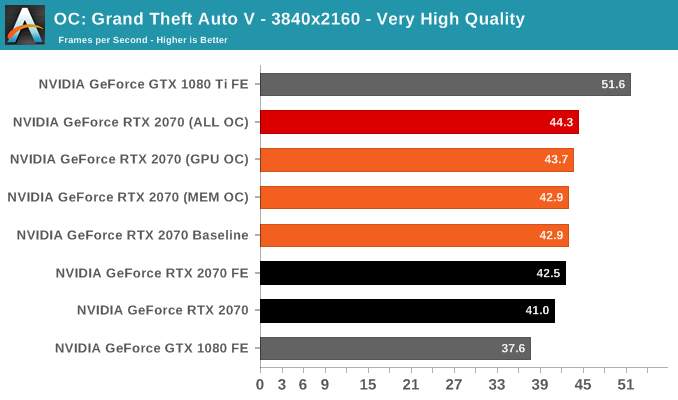

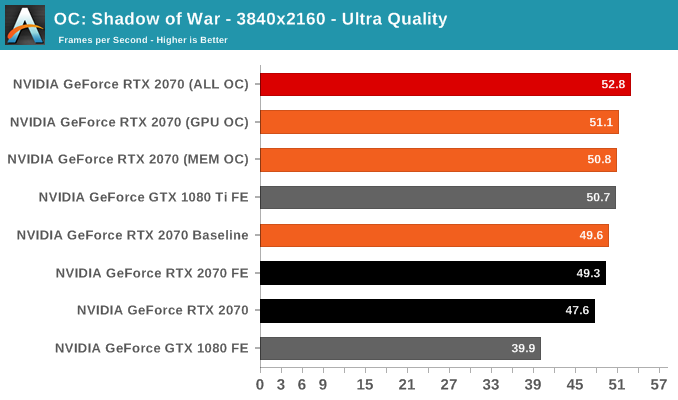
Although this is more of a cursory look than anything else, the combined overclock provides the best performance, just like it was for the Pascal based cards like the GTX 1080 and 1070. Given the GDDR6-equipped 2070, we would expect memory overclocking to be less effective, though it appears it's necessary for the best overclock here. Ultimately, the combined overclock can make up some ground, but the extent of its benefits are largely comparable to Pascal cards.
OC Power, Temperature, and Noise
There isn't much to add on the power, temperature, and noise front. The card will heats up a few more degrees, but kept relatively quiet thanks to its open air cooler. The full OC costs about ~30W at the wall in games, bringing it up to 1080 Ti FE levels, though only select games will see an overclocked RTX 2070 surpass the 1080 Ti.
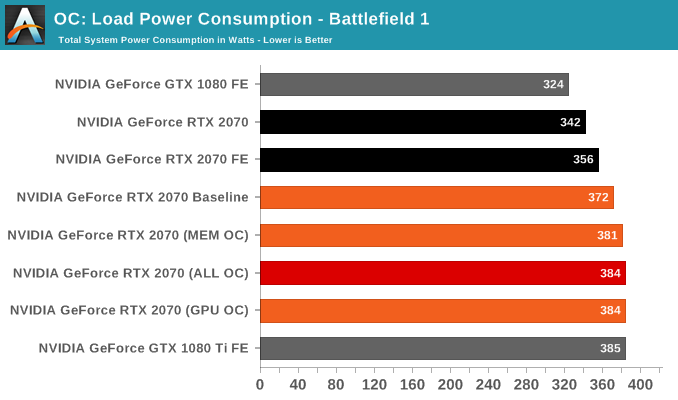
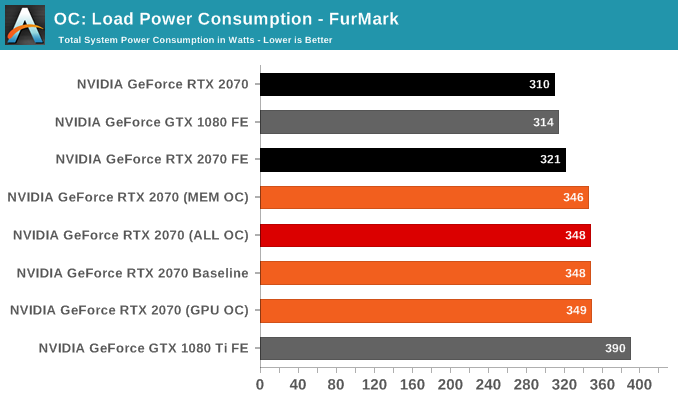
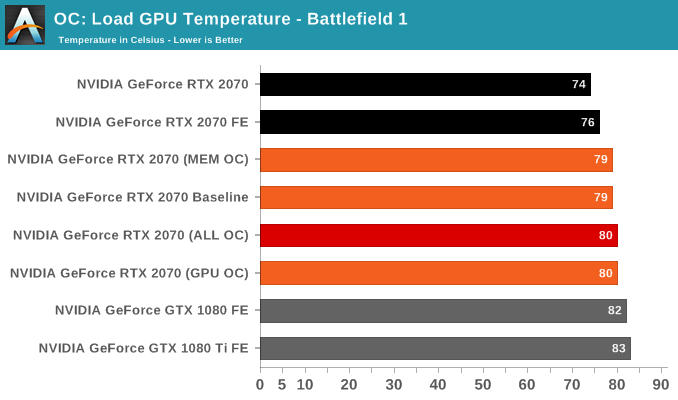
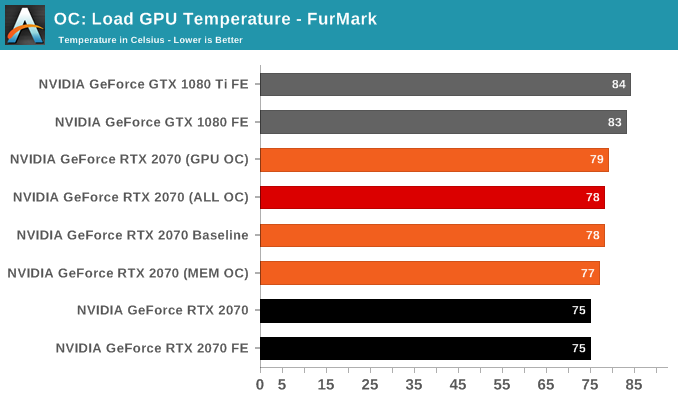

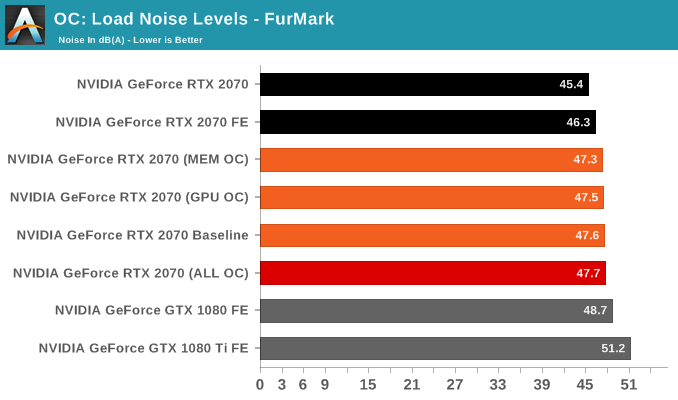










121 Comments
View All Comments
TheinsanegamerN - Tuesday, October 16, 2018 - link
Because the 2070 is a 1070 replacement? Why do you people get hung up on "WELL IT COST A BUNCH SO ITS A HIGH TIER CARD"No, it isnt, its a mid tier card with a high tier pricetag. It doesnt make sense to compare the 2070 to a 1080ti because of the pricetag, anymore then comparing a vega 64 to a 1070 because they both cost $400 at some point.
ioni - Tuesday, October 16, 2018 - link
2070's die size is closer to the 1080 ti than it is to the 1080. It should be, at minimum, being compared to a 1080.Nioktefe - Tuesday, October 16, 2018 - link
Exactly, it could be called RTX 2050 and still use the same chip, don't compare marketing with die specifications, RTX chips are huge, and they are priced accordingly to that, we will never see 2080Ti come close to 1080ti pricesPeachNCream - Tuesday, October 16, 2018 - link
^^ So much of this right here! Name it what whatever, but the retail price is ultimately what dictates what it must compete with from prior generations or from the nearest competitor. As far as pricing is concerned, the RTX 2070 must contend with the GTX 1080Ti and 1080 when a present day buyer is looking at options in that price range.tamalero - Wednesday, October 17, 2018 - link
die size is irrelevant, price points is what is important in price brackets.. if the 2070 is on 1080gtx prices for a tiny improvement, its not worth it..Vayra - Monday, October 22, 2018 - link
Die size is not irrelevant. Cause & Effect: larger die = lower yield per wafer = higher price.CheapSushi - Thursday, October 18, 2018 - link
Do you make your choice based on die size OR price?dguy6789 - Tuesday, October 16, 2018 - link
What an absolutely ridiculous statement. People don't cross shop products that have radically different pricing- they pick a budget and look for what is best in that price segment. Hmmm I'm torn between a Kia and a BMW. Yeah right.evilspoons - Wednesday, October 17, 2018 - link
That's reasonable, the Kia Stinger is a pretty decent RWD/AWD luxury sedan. For like $45k CAD you get roughly what you'd have to pay $65k CAD to get in a BMW, so a $45k BMW by contrast is a much less interesting vehicle. (Although personally, I'd go with the Genesis G70 instead of the Kia, you can get it with a 6-speed manual.)khanikun - Friday, October 19, 2018 - link
Car analogies do and don't work here. Some might start with size, while other start with price. Some will start with looks, some will start with power, some will start with drivetrain, etc. Some will cross shop products that have different prices, some won't.Some might be torn between a Kia and a BMW, if both made rwd sports cars that compete against each other, even with a price tag difference. Look at all the comparisons between something like a Subaru WRX STI vs a BMW M3, even though the M3 is easily $20k over the STI.
The only time I see someone set a budget first, is those looking at the used car market. Not the looking at the new car market.